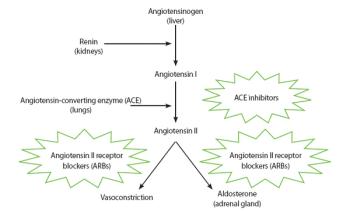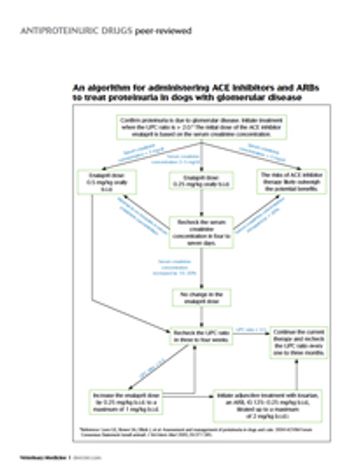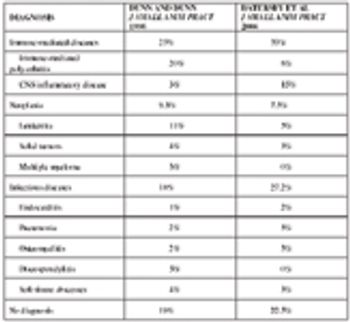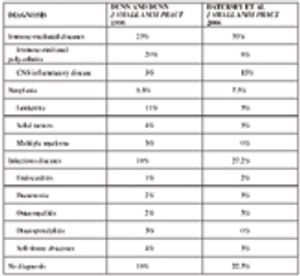
Dr. Barrak Pressler lays out the case for administering ACE inhibitors and angiotensin II-receptor blockers.
Department of Veterinary Clinical Sciences
School of Veterinary Medicine
Purdue University
West Lafayette, IN 47907

Dr. Barrak Pressler lays out the case for administering ACE inhibitors and angiotensin II-receptor blockers.

Download this suggested protocol for treating proteinuria in dogs.

For most diagnostic tests, the 'titer' is the minimum dilution of a substance that is required to yield a positive result. For example, for detection of anti-Leptospira sp. Antibodies, the titer is the dilution of serum which still causes microbes to crosslink.

In human medicine, fever of unknown origin (FUO) is defined as pyrexia of greater than two to three weeks duration (i.e. sufficient time for self-limiting infections to resolve) during which repeat physical examinations and standard diagnostic testing have failed to reveal an underlying cause.

Dogs with immune-mediated thrombocytopenia (ITP) usually present with platelet counts low enough to be considered life-threatening, although overt signs of bleeding are uncommon. Owners usually only note anorexia or lethargy, although in some cases epistaxis, cutaneous bruising/petecchi?/echymoses, or oral bleeding may be noted.

Immune-mediated hemolytic anemia is one of the most common reasons for referral to veterinary internists. The most common presenting complaint is that the patient is inadequately responding to appropriate imunosuppression.

Nontraumatic inflammatory joint disease is a relatively common, but under-recognized, cause of fever and morbidity in dogs. In one review of 66 dogs referred for fever of unknown origin to a veterinary teaching hospital, approximately 8% were diagnosed with immune-mediated polyarthritis.

Non-core vaccines are those which we as a profession have determined are not recommended for all dogs or cats. Vaccination, in general, has the benefit of potentially lessening the prevalence or severity of disease, ensuring that patients are examined on a regular basis, increasing practice revenue, and potentially saving clients money in the long-run.

Glucocorticoids are the most commonly used drugs for immunosuppression of dogs and cats with immune-mediated diseases because they induce rapid, non-specific inhibition of the immune system by reducing inflammation-associated gene transcription, inhibiting intracellular signaling pathways, down-regulating cell membrane expression of adhesion proteins, and slowing cell proliferation.

Take a look at four immunosuppressants used in people that may soon be incorporated into immunosuppressive protocols in veterinary medicine as well.

Non-core vaccines are those which we as a profession have determined are not recommended for all dogs or cats. Vaccination, in general, has the benefit of potentially lessening the prevalence or severity of disease, ensuring that patients are examined on a regular basis, increasing practice revenue, and potentially saving clients money in the long-run.

Nephrotic syndrome is an uncommon to rare complication of protein-losing nephropathies. Diagnosis of nephrotic syndrome requires the concurrent presence of proteinuria, hypoalbuminemia, third-space accumulation of fluid, (such as ascites) and hyperlipidemia; when present, this diagnosis is pathognomonic for glomerular disease.

For most diagnostic tests, the 'titer' is the minimum dilution of a substance that is required to yield a positive result.

In human medicine, fever of unknown origin (FUO) is defined as pyrexia of greater than two to three weeks duration (i.e. sufficient time for self-limiting infections to resolve) during which repeat physical examinations and standard diagnostic testing have failed to reveal an underlying cause.

Conventional urine dipsticks are the standard initial screening test for detection of proteinuria. Urine albumin concentration must be approximately 30 mg/dl or greater to be detected by this method.

Crystalluria: Struvite crystalluria occurs in greater than 50% of healthy dogs, including animals without urinary tract infections; these crystals are also common in healthy cats. Incidental struvite crystalluria occurs because the mineral components of these crystals (magnesium, ammonia, phosphate) are normally excreted in large amounts into urine, and supersaturation leads to precipitation.

In addition to the CBC and chemistry panel, the urinalysis is the third component of the minimum database. In addition to helping in the evaluation and monitoring of diseases of the kidneys and the lower urinary tract, a urinalysis provides information on the function of a number of other organs.

Nontraumatic inflammatory joint disease is a relatively common, but under-recognized, cause of fever and morbidity in dogs. In one review of 66 dogs referred for fever of unknown origin to a veterinary teaching hospital, approximately 8% were diagnosed with immune-mediated polyarthritis.

Urine sediment examination is an essential part of the urinalysis. As discussed in the previous lecture, a urinalysis should be performed whenever blood is collected for a 'metabolic screen' or 'healthy animal exam,' or a clinician is investigating any systemic disease.

Dogs with immune-mediated thrombocytopenia (ITP) usually present with platelet counts low enough to be considered life-threatening, although overt signs of bleeding are uncommon.

Immune-mediated hemolytic anemia is one of the most common reasons for referral to veterinary internists. The most common presenting complaint is that the patient is inadequately responding to appropriate immunosuppression.

The reasons why proteinuria is directly associated with progression of renal disease are multifactorial.

There is no question that glucocorticoids (GCs) remain the mainstay of immunosuppressive therapy in small animal medicine. However other drugs are available that can be used in conjunction with GCs in order to provide synergistic immunosuppression and thus allow lower GC dosage, more specifically target certain arms of the immune system, and provide proven superior immunosuppression to GCs in a few diseases.

This internist has a passion for teaching and sees great changes ahead in the realm of veterinary education. "The future of veterinary medicine lies in subcertification, meaning students being trained only in small-animal or large-animal medicine."

Published: November 1st 2010 | Updated:

Published: November 1st 2010 | Updated:

Published: November 1st 2010 | Updated:

Published: November 1st 2010 | Updated:

Published: November 1st 2010 | Updated:

Published: November 1st 2010 | Updated: